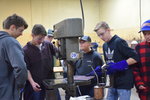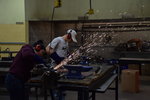

The Ridgefield School District is eyeing a $107 million capital facilities bond in order to meet the demands of ever-present population growth, adding to plans initially found in a ballot measure from last year that failed to meet the 60 percent supermajority to pass.
The district has put the bond on the February special election ballot with plans to build two new schools, expand Ridgefield High School and construct accessible playgrounds at district elementaries. The ballot measure follows an attempt in 2019 to pass a $77 million bond with a similar aim on improvements, though it was only able to receive 58 percent approval, which is not enough for bonds to pass in Washington State.
Chief among the components that a bond would fund are two new schools — a 72,000-square-foot K-4 elementary school and a roughly 50,000-square-foot fifth- and sixth-grade intermediate school. Those new buildings, along with expansion at the high school, would allow RSD to handle growth projections, district officials said. They expect to see an increase of 1,760 students in the next five years.
RSD Superintendent Nathan McCann said the elementary school design has been ready for a year from work around the 2019 bond, though it is expected to cost $4 million more than the estimate a year ago. The intermediate school that would be the first phase of a similar campus as the current View Ridge/Sunset Ridge complex completed as a result of the successful 2017 bond.
Land for the elementary school has already been secured, as in 2018 the board approved the purchase of about 27 acres located next to Claiborne Acres off of Northwest 279th Street, east of Clark County Fire and Rescue’s Northwest 65th Avenue station. The intermediate school would be placed on land the district is eyeing on the south side of the district. McCann said that it and the previous land purchase would be funded through school impact fees paid by developers in the district, not from funds directly raised from the bond.
McCann said that if passed the bond would raise the tax rate in the district by 97 cents per $1,000 of assessed value, or an increase of $291 annually on a $300,000 home.
Though initially the district was entertaining a remodel of the current vocational building, a year’s worth of analysis pointed to building a new one and repurposing the current facility as making more sense. The building would be used for district warehousing, filling a gap on space the district currently faces, McCann explained.
Ridgefield High School shop teacher Chris Shipp, himself a 2002 graduate of RHS, said there hasn’t been much change in what the building has to offer since he was in school. He said in the more than 40 years since the facility was built, the wear and tear has taken its toll, listing a slew of deficiencies ranging from lack of regular repainting to issues with the ventilation system.
Shipp mentioned that the electrical system isn’t adequate to hook up all of the machines the building has, and in some cases there aren’t enough machines to serve class sizes without requiring students to share. He said that improvements to the vocational building would allow the high school to offer programs more competitive with other districts, ones more relevant to the current workforce
“We will be able to have kids come out of here that are able to work in welding or manufacturing or construction fields that really aren’t being addressed at this point, coming up to industry standards,” Shipp said.
Though the new vocational building would be slightly smaller — 10,000 square feet to the current 12,000 — McCann said the current layout isn’t ideal for its current use, meaning a more optimized spread would have better use even with a lesser footprint.
McCann stressed that the district was conservative in its estimates of what could be completed given the bond amount, mentioning in some cases other districts had to scale back their overall scope of projects as costs rose. The 10,000 square feet was a “basement” for what the district anticipates it could cover, part of an overall 28,000-square-foot project at the high school that included additional classrooms.
RSD School Board President Scott Gullickson mentioned the district was able to deliver more square footage on projects found in the past two previous bonds.
If the bond doesn’t manage to pass next month, McCann said the school board had been insistent that alternatives would not be acceptable for keeping up with the district’s standards.
“There is not a plan should the bond not pass that is an acceptable or dependable plan,” McCann said. The district would have an increased reliance on portable buildings, going from the 23 current units to a minimum of 57 to meet population needs. That avenue would also require a bond to bring in those units.
Other alternatives would be changing program offerings to more general classroom space, with McCann giving examples of repurposing library or cafeteria space which had its own complications. To use current capacity the district could also have multiple class “shifts” though that would extend the total school day, adding to operational costs.
“It’s a huge step backwards for a district that prides itself on being a destination district and a destination community,” McCann said about the alternatives. Making those changes, like having school day shifts, would be hard to reverse should the district ever be in a position to return to a more conventional schedule or setup.
If the bond passes, McCann said construction on the elementary school would start as soon as possible, potentially in April, with completion ahead of the 2021-2022 school year. The new intermediate school and high school expansion would both break ground in Spring 2021 for completion in time for the 2022-2023 school year, and there was a chance to have accessible playgrounds complete over the summer.
On the second time around, McCann said that outreach was more robust than it had ever been when the district has sought a construction bond, leading him to feel optimistic about the chances the bond had on passing.
“I feel better today than I did a year ago about this,” McCann remarked.